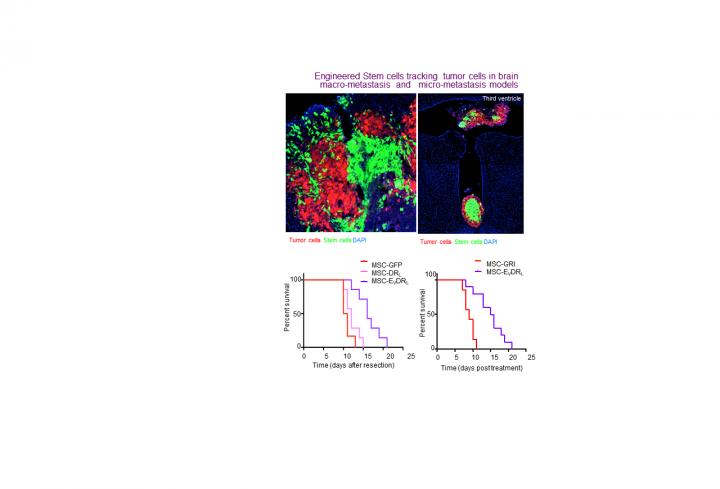Investigators developed a biology-driven, Stem-Cell therapy against key targets in a solid tumor; delivery occurred across the blood-brain barrier in mouse models designed to faithfully mimic metastatic cancer

Credit: Khalid Shah lab, Brigham and Women’s Hospital
Approximately 15-to-30 percent of patients with metastatic breast cancer have brain metastasis (BM), with basal-like breast cancer (BLBC) metastasizing to the brain most frequently. The prognosis for BLBC-BM patients is poor, as the blood-brain barrier prevents most therapeutics from reaching the brain. Testing candidate therapies in clinical trials is also challenging because animal models that mimic BM are limited. In a new study, researchers from Brigham and Women’s Hospital and collaborators engineered a bimodal tumor-suppressing and killing molecule that can be delivered to the brain by stem cells. They tested the therapy in three new mouse models of BLBC-BM that imitate human cancers and found that it successfully prolonged the lifespan of the mice. Findings are published in Science Advances.
“When breast cancer patients get metastasis to the brain, there’s often not much we can do because therapeutics for brain metastatic cancer are scarce,” said corresponding author Khalid Shah, MS, PhD, of the Center for Stem Cell Therapeutics in the Brigham’s Department of Neurosurgery. “Given the urgent need and magnitude of the problem, we set out to not only work on the development of a new therapeutic approach, but also to develop it in a way that maximizes the likelihood that our findings will be clinically translatable.”
The researchers began their work by analyzing tissue from breast tumors and metastatic tumors in the brain from human patients with BM. They pinpointed key targets that appeared to drive tumor growth: an excess of epidermal growth factor receptor (EGFR) and death receptors 4 and 5 (DR4/5). With this knowledge, the investigators genetically engineered a bi-functional molecule, EvDRL, to target EGFR and DR4/5 simultaneously and induce cell death in the tumors.
Because breast cancer can metastasize to the brain in numerous patterns, the researchers spent three years building BM mouse models to reflect the range and complexity of human disease. One mouse mimics metastasis that takes the form of a solid tumor in the middle of the brain (macro-metastasis), the second mimics a more scattered metastasis (perivascular niche micro-metastasis), and the third mimics one that appears in the back of the brain (leptomeningeal metastases). Armed with these models, they could more accurately determine the efficacy of the therapeutic molecule, EvDRL.
To introduce EvDRL to the brains of the metastasis mouse models, the researchers developed a stem-cell-based delivery platform. Stem cells have the advantage of being able to cross the BBB and home in on tumors in the brain. Allogeneic stem cell therapies, which use donor tissue samples to create large batches of cells, can produce stem cells efficiently, making them a readily available, “off-the-shelf” technology for administering therapies. In all three mouse models, the researchers observed improved survival rates.
“Building these models was essential to testing our therapies because we wanted to mimic what happens in the patients,” Shah said. “We started our research by bringing findings in patients to mice, and now we are planning to go back to the patients.”
###
The U.S. Food and Drug Administration is currently reviewing a previous iteration of the researchers’ novel therapy, which uses off the shelf stem cells to zero in on one of the two proteins targeted by EvDRL. They hope that approval of that therapy might bolster support for clearance of the therapy developed and used in their current study.
Funding for this research was provided by NIH grants R01-CA201148 and R01-NS107857, Overseas Research Fellowships from Uehara Memorial Foundation, and Kanzawa Medical Research Foundation. Shah owns equity in and is a member of the Board of Directors of AMASA Therapeutics, a company developing stem cell-based therapies for cancer.
Paper cited: Kitamura, Y et al. “Anti-EGFR VHH-armed death receptor ligand-engineered allogeneic stem cells have therapeutic efficacy in diverse brain metastatic breast cancers” Science Advances DOI: 10.1126/sciadv.abe8671
Media Contact
Eliza Powell
[email protected]
Related Journal Article
http://dx.



